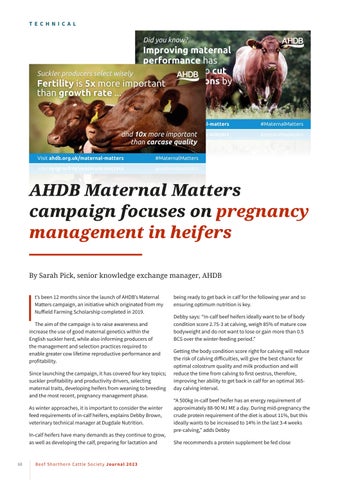T E C H N I C A L
AHDB Maternal Matters campaign focuses on pregnancy management in heifers By Sarah Pick, senior knowledge exchange manager, AHDB
I
t’s been 12 months since the launch of AHDB’s Maternal Matters campaign, an initiative which originated from my Nuffield Farming Scholarship completed in 2019.
The aim of the campaign is to raise awareness and increase the use of good maternal genetics within the English suckler herd, while also informing producers of the management and selection practices required to enable greater cow lifetime reproductive performance and profitability. Since launching the campaign, it has covered four key topics; suckler profitability and productivity drivers, selecting maternal traits, developing heifers from weaning to breeding and the most recent, pregnancy management phase. As winter approaches, it is important to consider the winter feed requirements of in-calf heifers, explains Debby Brown, veterinary technical manager at Dugdale Nutrition. In-calf heifers have many demands as they continue to grow, as well as developing the calf, preparing for lactation and
68
B eef Shorthorn C attl e S oc i ety J o ur n al 2 0 2 3
being ready to get back in calf for the following year and so ensuring optimum nutrition is key. Debby says: “In-calf beef heifers ideally want to be of body condition score 2.75-3 at calving, weigh 85% of mature cow bodyweight and do not want to lose or gain more than 0.5 BCS over the winter-feeding period.” Getting the body condition score right for calving will reduce the risk of calving difficulties, will give the best chance for optimal colostrum quality and milk production and will reduce the time from calving to first oestrus, therefore, improving her ability to get back in calf for an optimal 365day calving interval. “A 500kg in-calf beef heifer has an energy requirement of approximately 88-90 MJ ME a day. During mid-pregnancy the crude protein requirement of the diet is about 11%, but this ideally wants to be increased to 14% in the last 3-4 weeks pre-calving,” adds Debby She recommends a protein supplement be fed close













































